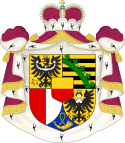First Josef Hoop cabinet
First Josef Hoop cabinet | |
|---|---|
Government of Liechtenstein | |
 Hoop's cabinet in 1928. Ludwig Marxer is missing from the photograph. | |
| Date formed | 6 August 1928 |
| Date dissolved | 28 February 1936 |
| People and organisations | |
| Head of state | Johann II Franz I |
| Head of government | Josef Hoop |
| Deputy head of government | Ludwig Marxer Anton Frommelt |
| Total no. of members | 6 |
| Member parties | FBP VP |
| History | |
| Election(s) | 1928 1932 |
| Predecessor | Gustav Schädler cabinet |
| Successor | Second Hoop cabinet |
 |
|---|
| ||
|---|---|---|
|
Prime Minister of Liechtenstein 1928–1945   |
||
The first Josef Hoop cabinet was the governing body of Liechtenstein from 6 August 1928 to 28 February 1936. It was appointed by Johann II and continued by his successor Franz I. It was chaired by Josef Hoop.
History[edit]
The government of Gustav Schädler was forced to resign by Johann II in the wake of an embezzlement scandal involving the National Bank of Liechtenstein and early elections were called.[1] The 1928 Liechtenstein general election resulted in a win for the Progressive Citizens' Party and Josef Hoop was appointed as Prime Minister of Liechtenstein.[2] The party was able to govern alone and in the 1930 Liechtenstein by-election was the sole party in the Landtag of Liechtenstein until 1932 when it once again entered a coalition with the Christian-Social People's Party.[3][4]
The government's term was characterized by the Great Depression in addition to the building of a 23km long inland canal in order to increase the percentage of arable land within the country and to create job opportunities within the country, which was approved in 1930 and started construction in 1931.[5]
It also tried to diffuse domestic tensions within Liechtenstein, specially with increasing antisemitic agitation within the country throughout the 1930s, inspired by the rise of Nazi Germany in 1933 and the anti-Jewish laws which led to a large number of Jews taking refuge in the country.[6][7] Most notably, the Rotter kidnapping was designed to be an impetus for the formation of an organized Liechtenstein group, but it instead held back efforts for a time.[8]
After the 1936 Liechtenstein general election the cabinet was dissolved and succeeded by the Second Josef Hoop cabinet on 28 February 1936.[2][3]
Members[edit]
| Picture | Name | Term | Party | ||
|---|---|---|---|---|---|
| Prime Minister | |||||

|
Josef Hoop | 6 August 1928 –
28 February 1936 |
Progressive Citizens' Party | ||
| Deputy Prime Minister | |||||

|
Ludwig Marxer | 6 August 1928 –
20 June 1933 |
Progressive Citizens' Party | ||

|
Anton Frommelt | 20 June 1933 –
28 February 1936 |
Progressive Citizens' Party | ||
| Government councillors | |||||

|
Peter Büchel | 6 August 1928 –
28 February 1936 |
Progressive Citizens' Party | ||

|
Josef Gassner | 6 August 1928 –
18 March 1932 |
Christian-Social People's Party | ||

|
Josef Steger | 18 March 1932 –
28 February 1936 |
Christian-Social People's Party | ||
See also[edit]
References[edit]
- ^ Büchel, Donat (31 December 2011). "Sparkassaskandal". Historisches Lexikon des Fürstentums Liechtenstein (in German). Retrieved 18 May 2023.
- ^ a b Dieter Nohlen; Philip Stöver (2010). Elections in Europe: A data handbook (in German). p. 1164. ISBN 978-3-8329-5609-7.
- ^ a b Paul Vogt (1987). 125 Jahre Landtag. Vaduz: Landtag of the Principality of Liechtenstein.
- ^ Dieter Nohlen; Philip Stöver (2010). Elections in Europe: A data handbook (in German). p. 1182. ISBN 978-3-8329-5609-7.
- ^ Haidvogl, Gertrud (31 December 2011). "Binnenkanal". Historisches Lexikon des Fürstentums Liechtenstein (in German). Retrieved 30 July 2023.
- ^ TIMES, Wireless to THE NEW YORK (1933-07-03). "Nazi Group Formed in Lichtenstein". The New York Times. ISSN 0362-4331. Retrieved 10 June 2023.
- ^ "Regierungschef Josef Hoop orientiert den Landtag über einen Entwurf für ein Staatsbürgerschaftsgesetz". Staatsarchiv des Fürstentum Liechtenstein (in German). 29 May 1933. Retrieved 28 July 2023.
- ^ Editorial (16 August 2021). "Rotter-Entführung". Historisches Lexikon des Fürstentums Liechtenstein (in German). Retrieved 23 March 2024.

